Abstract
Weakly oncogenic adenovirus 2 (Ad2)-transformed LSH hamster cells are sensitive to lysis by spontaneously cytolytic lymphoid cells and activated macrophages, whereas highly oncogenic simian virus 40 (SV40)-transformed LSH cells are relatively resistant to these nonspecific effector cells. Somatic cell hybrids formed between Ad2- and SV40-transformed hamster cells, which expressed Ad2 tumor (T) antigens, exhibited an increased cytolytic susceptibility compared to Ad2 T antigen-negative cell hybrids or nonhybrid SV40-transformed cells. No correlation was found between the expression of SV40 T antigen in hybrid cells and cytolytic susceptibility. The results suggest the existence of a novel function for early Ad2 genome-encoded polypeptides (T antigens) expressed in transformed hamster cells--the induction of susceptibility to destruction mediated by immunologically nonspecific effector cells.
Full text
PDF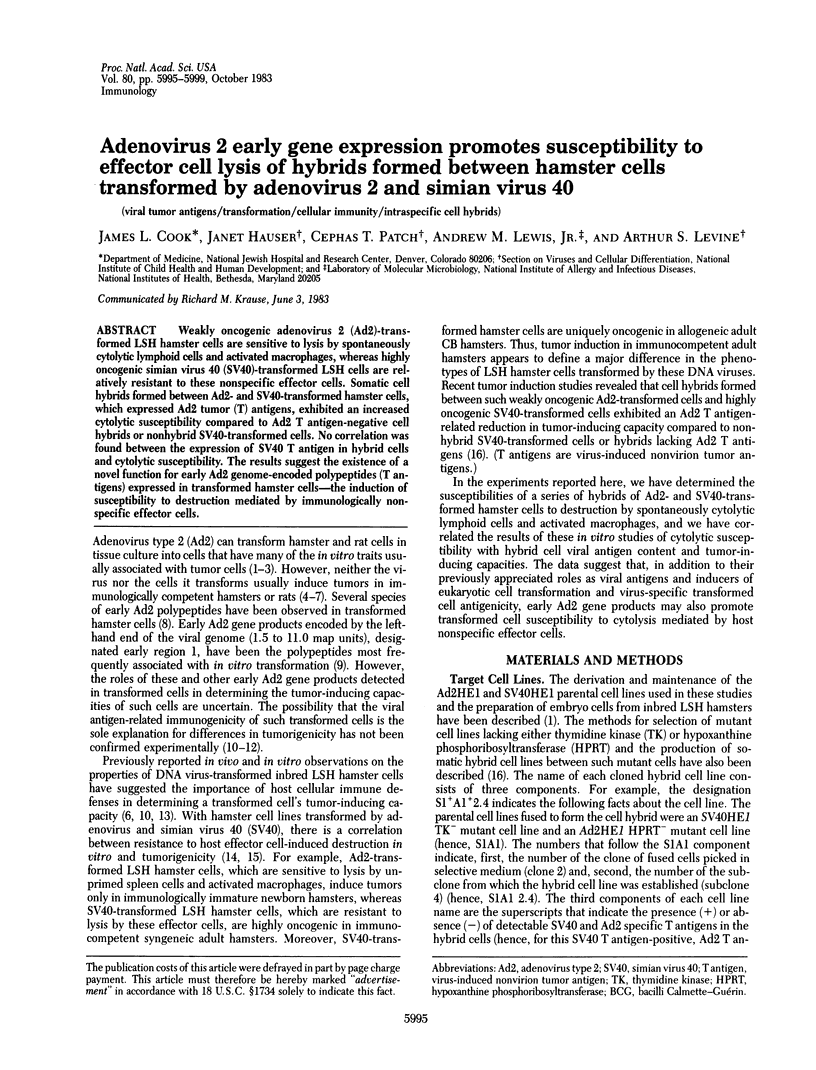
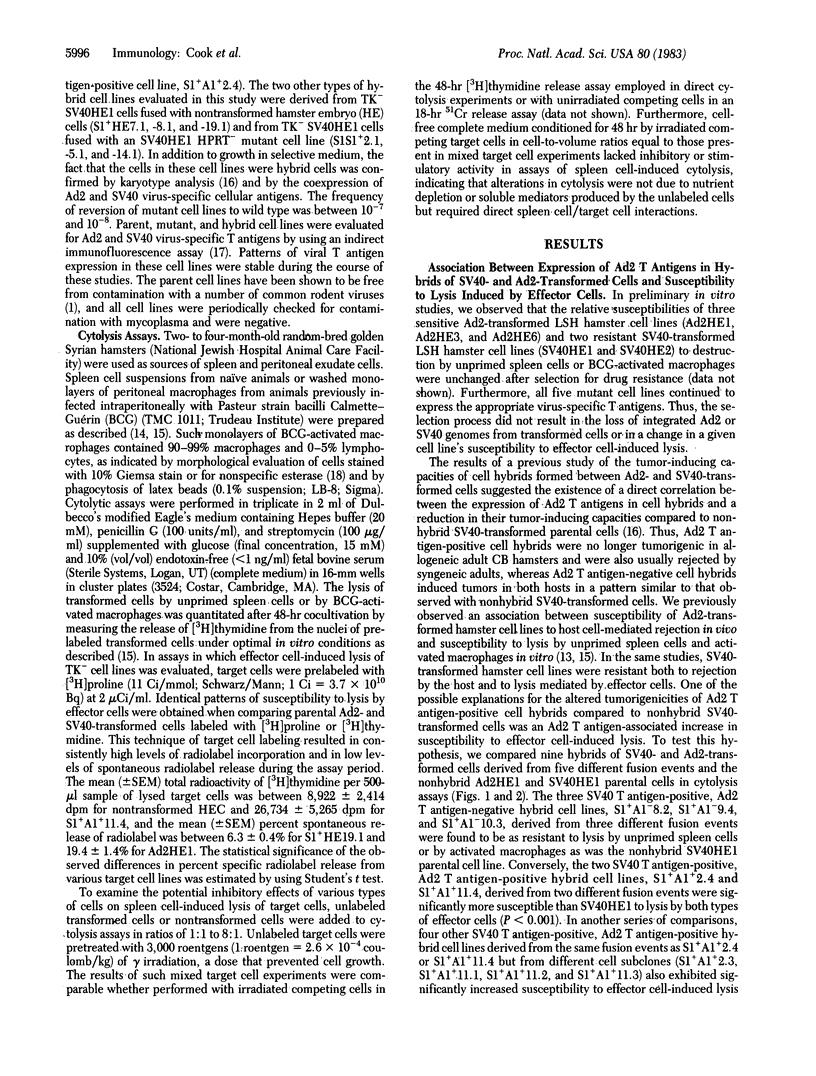
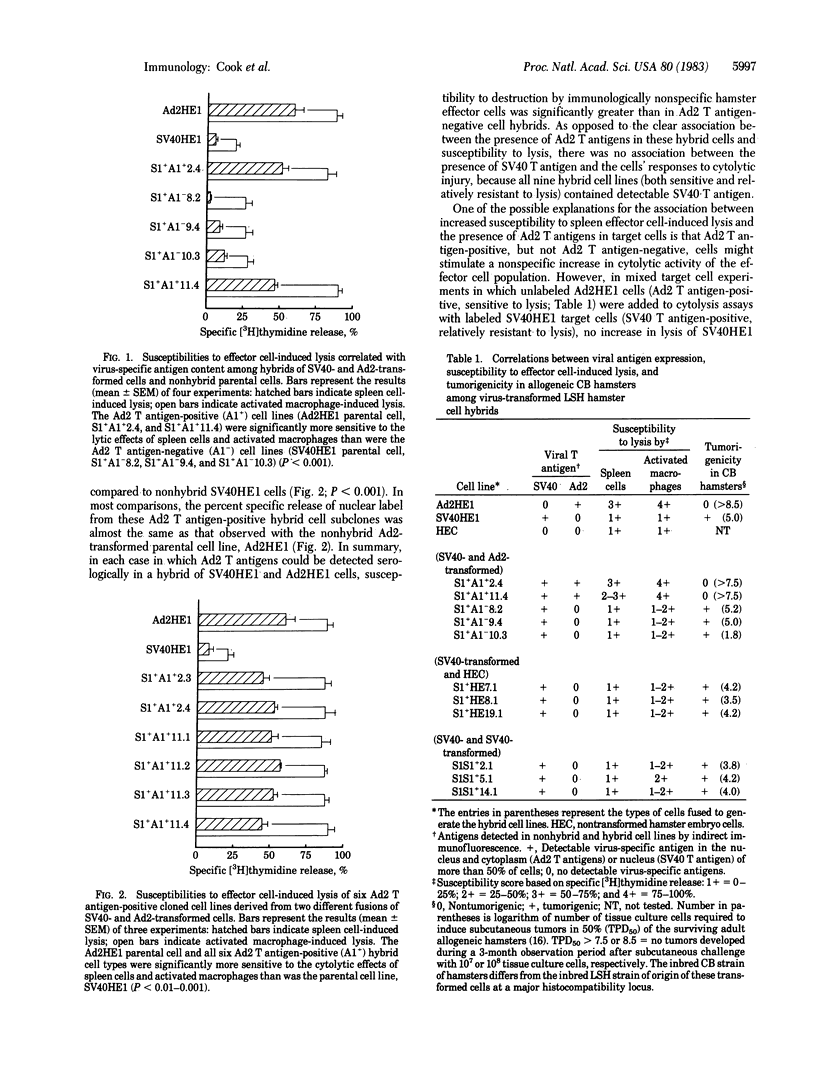
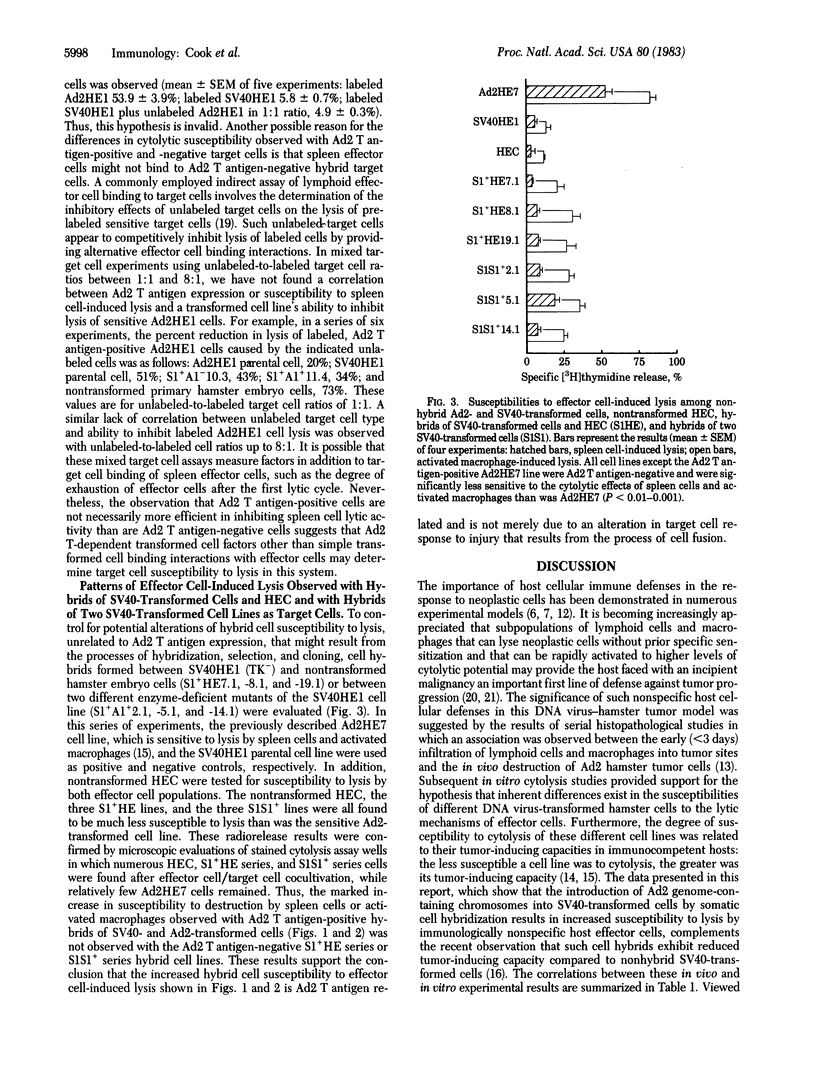
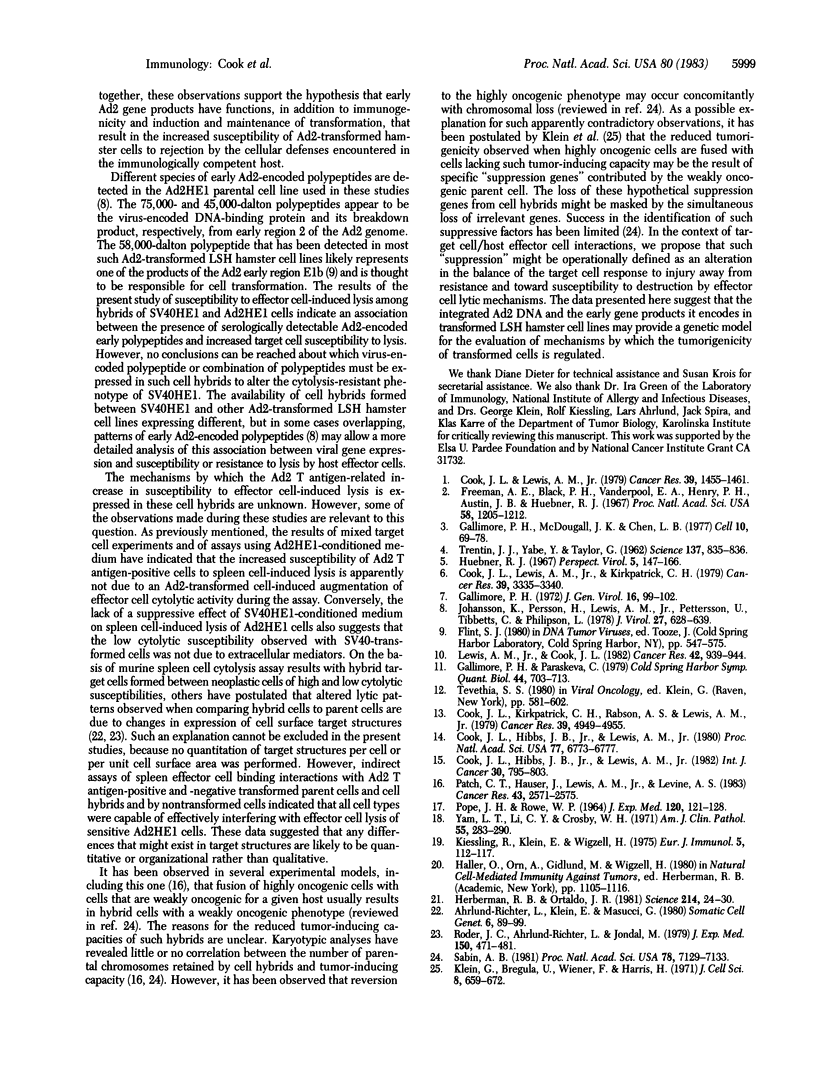
Selected References
These references are in PubMed. This may not be the complete list of references from this article.
- Ahrlund-Richter L., Klein E., Masucci G. Somatic hybrids between a high NK-sensitive lymphoid (YACIR) and several low sensitive sarcoma or L-cell-derived mouse lines exhibit low sensitivity. Somatic Cell Genet. 1980 Jan;6(1):89–99. doi: 10.1007/BF01538698. [DOI] [PubMed] [Google Scholar]
- Cook J. L., Hibbs J. B., Jr, Lewis A. M., Jr DNA virus-transformed hamster cell--host effector cell interactions: level of resistance to cytolysis correlated with tumorigenicity. Int J Cancer. 1982 Dec 15;30(6):795–803. doi: 10.1002/ijc.2910300619. [DOI] [PubMed] [Google Scholar]
- Cook J. L., Hibbs J. B., Jr, Lewis A. M., Jr Resistance of simian virus 40-transformed hamster cells to the cytolytic effect of activated macrophages: a possible factor in species-specific viral oncogenicity. Proc Natl Acad Sci U S A. 1980 Nov;77(11):6773–6777. doi: 10.1073/pnas.77.11.6773. [DOI] [PMC free article] [PubMed] [Google Scholar]
- Cook J. L., Kirkpatrick C. H., Rabson A. S., Lewis A. M., Jr Rejection of adenovirus 2-transformed cell tumors and immune responsiveness in Syrian hamsters. Cancer Res. 1979 Dec;39(12):4949–4955. [PubMed] [Google Scholar]
- Cook J. L., Lewis A. M., Jr Host response to adenovirus 2-transformed hamster embryo cells. Cancer Res. 1979 May;39(5):1455–1461. [PubMed] [Google Scholar]
- Cook J. L., Lewis A. M., Jr, Kirkpatrick C. H. Age-related and thymus-dependent rejection of adenovirus 2-transformed cell tumors in the Syrian hamster. Cancer Res. 1979 Sep;39(9):3335–3340. [PubMed] [Google Scholar]
- Freeman A. E., Black P. H., Vanderpool E. A., Henry P. H., Austin J. B., Huebner R. J. Transformation of primary rat embryo cells by adenovirus type 2. Proc Natl Acad Sci U S A. 1967 Sep;58(3):1205–1212. doi: 10.1073/pnas.58.3.1205. [DOI] [PMC free article] [PubMed] [Google Scholar]
- Gallimore P. H., Paraskeva C. A study to determine the reasons for differences in the tumorigenicity of rat cell lines transformed by adenovirus 2 and adenovirus 12. Cold Spring Harb Symp Quant Biol. 1980;44(Pt 1):703–713. doi: 10.1101/sqb.1980.044.01.075. [DOI] [PubMed] [Google Scholar]
- Gallimore P. H. Tumour production in immunosuppressed rats with cells transformed in vitro by adenovirus type 2. J Gen Virol. 1972 Jul;16(1):99–102. doi: 10.1099/0022-1317-16-1-99. [DOI] [PubMed] [Google Scholar]
- Herberman R. B., Ortaldo J. R. Natural killer cells: their roles in defenses against disease. Science. 1981 Oct 2;214(4516):24–30. doi: 10.1126/science.7025208. [DOI] [PubMed] [Google Scholar]
- Johansson K., Persson H., Lewis A. M., Pettersson U., Tibbetts C., Philipson L. Viral DNA sequences and gene products in hamster cells transformed by adenovirus type 2. J Virol. 1978 Sep;27(3):628–639. doi: 10.1128/jvi.27.3.628-639.1978. [DOI] [PMC free article] [PubMed] [Google Scholar]
- Kiessling R., Klein E., Wigzell H. "Natural" killer cells in the mouse. I. Cytotoxic cells with specificity for mouse Moloney leukemia cells. Specificity and distribution according to genotype. Eur J Immunol. 1975 Feb;5(2):112–117. doi: 10.1002/eji.1830050208. [DOI] [PubMed] [Google Scholar]
- Klein G., Bregula U., Wiener F., Harris H. The analysis of malignancy by cell fusion. I. Hybrids between tumour cells and L cell derivatives. J Cell Sci. 1971 May;8(3):659–672. doi: 10.1242/jcs.8.3.659. [DOI] [PubMed] [Google Scholar]
- Lewis A. M., Jr, Cook J. L. Spectrum of tumorigenic phenotypes among adenovirus 2-, adenovirus 12-, and simian virus 40-transformed Syrian hamster cells defined by host cellular immune-tumor cell interactions. Cancer Res. 1982 Mar;42(3):939–944. [PubMed] [Google Scholar]
- POPE J. H., ROWE W. P. DETECTION OF SPECIFIC ANTIGEN IN SV40-TRANSFORMED CELLS BY IMMUNOFLUORESCENCE. J Exp Med. 1964 Aug 1;120:121–128. doi: 10.1084/jem.120.2.121. [DOI] [PMC free article] [PubMed] [Google Scholar]
- Patch C. T., Hauser J., Lewis A. M., Jr, Levine A. S. Suppression of the simian virus 40 tumorigenic phenotype in hybrid cells formed from simian virus 40- and adenovirus 2-transformed hamster embryo cells. Cancer Res. 1983 Jun;43(6):2571–2575. [PubMed] [Google Scholar]
- Roder J. C., Ahrlund-Richter L., Jondal M. Target-effector interaction in the human and murine natural killer system: specificity and xenogeneic reactivity of the solubilized natural killer-target structure complex and its loss in a somatic cell hybrid. J Exp Med. 1979 Sep 19;150(3):471–481. doi: 10.1084/jem.150.3.471. [DOI] [PMC free article] [PubMed] [Google Scholar]
- Sabin A. B. Suppression of malignancy in human cancer cells: issues and challenges. Proc Natl Acad Sci U S A. 1981 Nov;78(11):7129–7133. doi: 10.1073/pnas.78.11.7129. [DOI] [PMC free article] [PubMed] [Google Scholar]
- TRENTIN J. J., YABE Y., TAYLOR G. The quest for human cancer viruses. Science. 1962 Sep 14;137(3533):835–841. doi: 10.1126/science.137.3533.835. [DOI] [PubMed] [Google Scholar]
- Yam L. T., Li C. Y., Crosby W. H. Cytochemical identification of monocytes and granulocytes. Am J Clin Pathol. 1971 Mar;55(3):283–290. doi: 10.1093/ajcp/55.3.283. [DOI] [PubMed] [Google Scholar]


